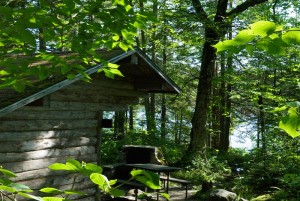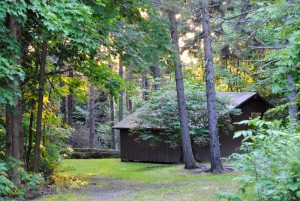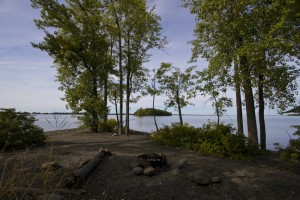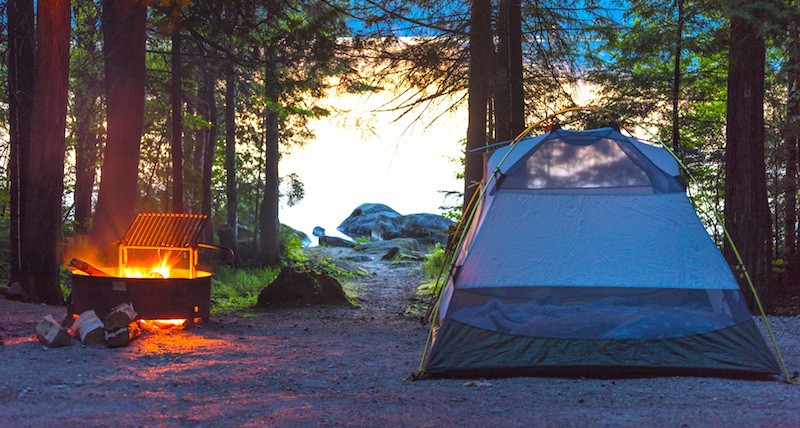8 Quiet Campsites
It’s camping season and if you want to find empty trails, remote cabins and ponds where you’ll be making the only ripples, escape to these 8 quiet campsites.
Everybody loves a good campsite. When the evenings start to cool, there’s nothing better than unplugging for a weekend of hiking, biking, paddling or just relaxing with a book in a hammock. Unfortunately, come September, you’re not the only one who wants to escape. This fall, you can avoid the crowds at these quieter campsites, many with cabins or lean-tos. Some are in state parks, some are accessed by the Long Trail or are on remote mountaintops. You’ll find views of lakes and mountains and some peace and quiet to enjoy them. Some state parks require reservations so check first with Vtstateparks.com.
Camp by a Glacial Lake
One of the most remote state parks sits on the shores of one of Vermont’s cleanest lakes. Formed by glaciers, clear, deep and milfoil-free Maidstone Lake sits near the New Hampshire border in the Northeast Kingdom. Record-size lake trout and salmon swim in this 726-acre lake that plunges to 120 feet deep. Loons paddle the waters, their calls echoing off the shores at night. Built by the Civilian Conservation Corps in the 1930s, the park still has many of the original campsite fireplaces and a log cabin-style main building. The 34 tent and RV sites can get busy during holiday weekends but after Labor Day, it’s easy to pitch a tent at one of the quieter sites right by the lake (or in one of the 25 lean-tos) and feel like you have the place to yourself. You can rent canoes and kayaks at Maidstone or bring your own. It’s less than an hour’s drive to the Silvio Conte Wildlife Refuge, Lake Willoughby or the Connecticut River.
Climb to a Mountaintop Cabin
One of Vermont’s oldest lookout stations is also a great spot for a quiet night in the Northeast Kingdom. At the summit of Bald Mountain (the third-highest peak in the region and one of many peaks by the same name in the state) stands a watchtower overlooking the Kingdom and New Hampshire’s White Mountains. While the Mad Brook Trail and the Long Pond Trail leading to the summit are great day hikes, at the top you can check into a restored cabin (it sleeps four) for an overnight camp. “The views from the summit are second to none,” says NorthWoods Stewardship Center’s Jayson Benoit. “But you’ll have to see a sunrise to really enjoy it.” Volunteers with the Green Mountain Club and the NorthWoods Stewardship Center finished work on the cabin in 2013 with new flooring and walls. There are no reservations: it’s a first-come, first-served basis, so if sleeping on the summit is your goal, get there early and bring a tent as a backup.
Explore Groton State Forest

One of Central Vermont’s gems, Groton State Forest spans some 26,164 acres. While the majority of the camping action is on two loops a quarter-mile apart in New Discovery State Park, you can escape the noise by heading to the neighboring Kettle or Osmore Ponds for one of fifteen remote campsites. “These are remote sites, it’s my idea of camping,” says Don O’Donnell, an administrator with New Discovery State Park. “The lakes are pristine and any neighbors will be at least half a mile away.” He’s not joking; one lean-to has the entire southern shore of Kettle Pond, meaning you’ll hear loons, and not loonies. Once set up, you’ll be at the entrance to the many miles of trails in the Groton State Forest, where you can hike, run, or mountain bike on multi-use trails, logging roads and abandoned powerline corridors. Popular nearby trails include the VAST Trail, the Cross Vermont Trail, and the Montpelier-Wells River Rail Trail.
Hide Out at Pico Camp
At the Route 4 parking area on the Sherburne’s Pass Trail you’ll find most people will be hiking toward Deer’s Leap, to the north of Route 4. Very few will be heading south on the blue-blazed trail, and that’s where a rustic cabin awaits. This trail served as the Long Trail/Appalachian Trail from 1913 until it was rerouted in the 1990s. Today, you can still hike this intermediate grade trail 2.7 miles through alpine forests near the Pico ski area to the Pico Camp cabin, which has stood since 1959. “The busiest portions of the Long Trail are north of Route 4,” says Jocelyn Hebert, editor of the GMC’s Long Trail News. “The southern portion, including cabins like this one will usually be quieter.” Through the windows of this historic cabin, you’ll have views to the ski slopes of Killington. Just half a mile uphill from the cabin, you’ll be at the summit of Pico Peak for views of the northern Green Mountains, Killington, Pico Pond and the cliffs at Deer Leap. This camp is available on a first-come, first-served basis, so arrive early and bring a tent in case it’s full.
Hike to Goddard Shelter
While you cook dinner at Goddard Shelter, you can see the beacon at the summit of Mount Greylock to the south in Massachusetts. Before settling in for the night, catch the sunset from the top of the firetower. The shelter is a spacious, three-sided lean-to that can sleep 12 on two levels. It also has one of the coldest, freshest spring-fed water on the Appalachian Trail. “Since the southern part of the Long Trail can be quieter than northern sections, this is truly one of the quietest shelters,” says the Green Mountain Club’s Matt Krebs. “Plus it has one of the longest road-free views in Vermont.” You can get to this shelter by way of the Long Trail about ten miles from its intersection with Route 9 in Woodford, or you can access it by way of the West Ridge trail, which advances along a nearby ridge for 11 miles.
Put In at Townshend
For a quiet spot in southern Vermont, head to Townshend State Park. Built in the 1920s by the Civilian Conservation Corps, it still has many of the old CCC-style tent platforms and an old stone building that serves as the park office. The place is not recommended for RVs. Instead, you’ll find 30 shady campsites (including nine with raised tenting platforms) and four lean-tos alongside a quiet brook with an ancient stone arch bridge. You can hike the moderate 1.7 miles to the summit of Bald Mountain for north, south and east views from its firetower or explore the nearby towns of Manchester and Brattleboro. On September 21 & 22, the area becomes a destination for whitewater paddlers with the scheduled release on the West River from the nearby Ball Mountain Dam. Get a campsite and bring your boat to join in the fun (there’s even a shuttle for paddlers), or your camera to shoot the action.
Stay at Vermont’s Second State Park
 In the Upper Valley, off Route 65, you’ll find one of Vermont’s oldest state parks. In 1928 when resident Wallace Allis willed his 625-acre Bear Mountain Farm to the state, this became Vermont’s second state park. This tiny park is a popular day-area (and it does have RV hookups). But it also has 18 tent sites and eight lean-tos, a log-cabin pavilions and firetower with sweeping views of central Vermont. The peaks of Killington, Pico, and Mt. Ascutney are visible to the south, Camel’s Hump and Mt. Mansfield to the north, Mt. Abraham, Lincoln and Ellen to the west and the White Mountains of New Hampshire to the east. Use this secluded park as a base camp for exploring on nearby ponds (North and South Pond are home to bullhead, brook trout and brown trout) or mountain biking on the new mountain bike trails around Randolph, just 13 miles down Route 12.
In the Upper Valley, off Route 65, you’ll find one of Vermont’s oldest state parks. In 1928 when resident Wallace Allis willed his 625-acre Bear Mountain Farm to the state, this became Vermont’s second state park. This tiny park is a popular day-area (and it does have RV hookups). But it also has 18 tent sites and eight lean-tos, a log-cabin pavilions and firetower with sweeping views of central Vermont. The peaks of Killington, Pico, and Mt. Ascutney are visible to the south, Camel’s Hump and Mt. Mansfield to the north, Mt. Abraham, Lincoln and Ellen to the west and the White Mountains of New Hampshire to the east. Use this secluded park as a base camp for exploring on nearby ponds (North and South Pond are home to bullhead, brook trout and brown trout) or mountain biking on the new mountain bike trails around Randolph, just 13 miles down Route 12.
Paddle Vermont’s Inland Sea

If you’ve got a boat, get yourself to one of the handful of campsites located on islands in northern Lake Champlain. While Burton Island State Park is a short boat ride from Killkare State park near St. Albans Bay, you can get even further away from the crowds with two islands accessed from South Hero. Located 3 miles from Knight Point State Park, Knight Island is home to six lean-tos and one tented campsite available for reservation through Vermont State Parks. Since they’re only accessed by boat, you’ll have morning and evening swims and a lakefront view that’s second to none. Meanwhile, nearby Woods Island has just five tent sites. Finish the trip with another short paddle to Burton Island. While larger and with more amenities like running water and electricity available at these campsites, you still won’t find any cars.
Learn more about island campsites by reading our article: 6 Island Campsites on Lake Champlain
Updated June, 2019.

